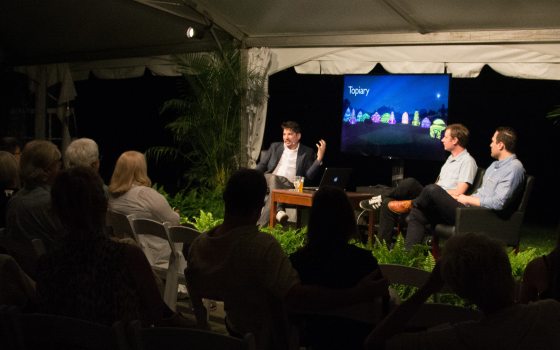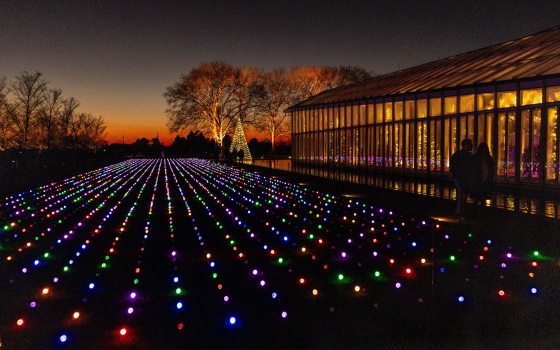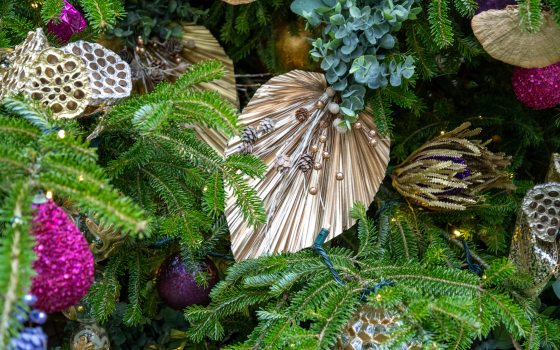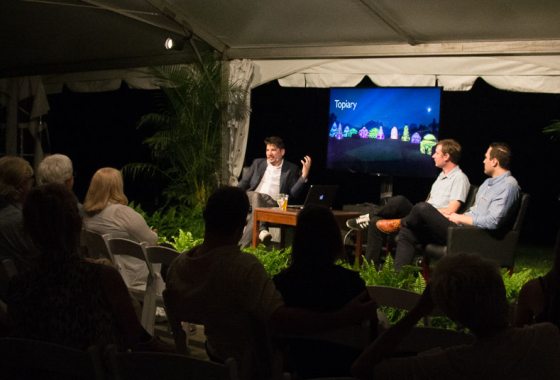
Ricardo Rivera of Klip Collective with composers for Nightscape. Photo by Heather Coletti.
Last Friday, the first of four installments of the Artists & Friends Speakers Series took place with three panelists: Ricardo Rivera, director of Nightscape: A Light and Sound Experience by Klip Collective and founding member of Klip Collective; composer and musician Jon Barthmus of Sun Airway; and composer and musician Justin Geller of Pink Skull. Guests heard the panelists discuss their varied artistic backgrounds, and they also learned about the lengthy collaboration and development process for the sights and sounds that combine to create the Nightscape installations. The minds behind Nightscape are friends who have worked together on several different projects. When Rivera found out that Klip Collective would be working with Longwood Gardens, he knew right away that relying on Barthmus and Pink Skull for Nightscape’s music would perfectly bind together his video installations in different parts of the Gardens.
Rivera described the exhibit arcing in three major acts: Act I begins as guests leave the doors of the Visitor Center behind them and turn toward the Rose Arbor and Flower Garden Drive, and it continues to the Large Lake before doubling back on the Flower Garden Walk. The Large Lake serves as the stage for one of the biggest components of the installation. Barthmus recounted a nighttime visit to the lake that had him racing against an approaching thunderstorm as he turned over ideas for his music. “I came up with something really quick that ended up being the main melodic theme for the whole thing,” he recalled. Even though his plans were cut short by bad weather, the final soundtrack for the Lake helped the team achieve what Rivera calls an “epic and orchestral” mood for this spot. The artists agreed that the Large Lake has an intense emotional quality that has repeatedly resonated with viewers.
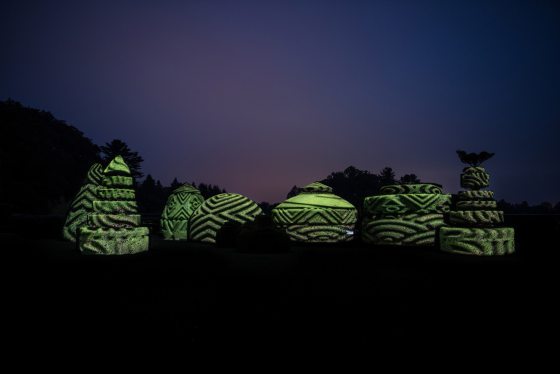
Nightscape in the Topiary Garden. Photo by Hank Davis.
Act II takes place in the Topiary Garden, which Rivera revealed as his favorite part of the exhibition. “It took forever to make this thing,” said Rivera. “I wanted to bring the Topiary to life beyond their sculptural element in this crazy, symphonic procession.” Rivera and Barthmus described how long it took to tie together the intricacies of both the music and light projections in this space. Guests should take their time in this spot to absorb fully the little pieces that come together on the larger scale of the Topiary.
Finally, the Conservatory contains Act III which Rivera described as an “epilogue/remix of everything you’ve seen outside”—a conclusion to the outdoor story experienced by the viewer. Rivera recruited the founding members of Pink Skull, Geller and fellow musician Julian Grefe, for the soundtrack inside the Conservatory. Two spots in the Conservatory particularly fascinated the artists and provided an inspiring canvas. For Geller, the Palm House served as a perfect example of their major task: translating the physical form of the plants into music and sound. In this room, the soundtrack conveys the unfurling of a palm’s fan-like fronds: the music begins as muffled but grows into a brighter, clearer sound timed to the lights that play on the fronds. Combined, these elements give the viewer a completely different perspective of these towering trees—one that can be experienced inside the glass enclosure of the Palm House itself or from outside in the Waterlily Display.
Rivera cited the Silver Garden as one of the most exciting canvases provided by the Conservatory. “Everything is gray—the perfect color for projection—and the textures are amazing.” Geller described how he and Grefe took photos of the different plants in the Silver Garden and paid close attention to the spirals and naturally recurring patterns in the elements of each plant. “We wanted these concepts in the music,” described Geller, and he and Grefe had no problem turning them into a soundtrack. Using a program that can turn photos into sound, Geller and Grefe created an entire soundtrack for the Silver Garden based on snippets of audio that resulted from the translation of the individual photographs. Combined with the light projections, Rivera explained that a viewer could stand in this room for an hour and experience something unique in every corner.
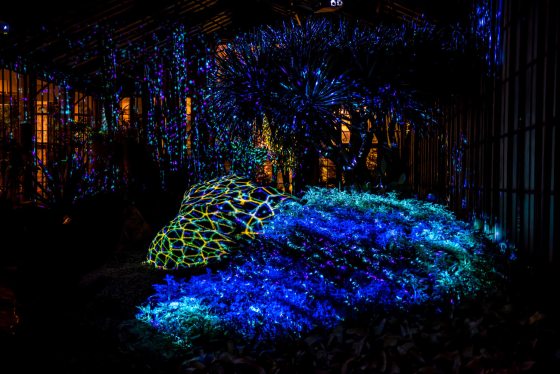
Nightscape in the Silver Garden. Photo by Hank Davis.
After listening to the artists describe their contributions to Nightscape, one thing became very clear: the best way to enjoy Nightscape is at an unhurried pace. Every element of the installation is intentional and deliberate. “Not until you walk through it,” advised Rivera, “do you really get it.”
The Sounds of Nightscape
Flower Garden Drive: Josh James, composer
Large Lake: John Barthmus, Sun Airway, composer of the musical score; Thom Roland, composer of ambient loop
Peirce’s Woods: Thom Roland, composer
Flower Garden Walk: John James, composer
Topiary Garden: John Barthmus, Sun Airway, composer of the musical score; Thom Roland, composer of ambient loop
East Conservatory: Julian Grefe and Justin Geller, Pink Skull, composers
Palm House: Julian Grefe and Justin Geller, Pink Skull, composers
Silver Garden: Julian Grefe and Justin Geller, Pink Skull, composers
